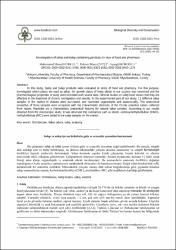| dc.contributor.author | Hürkul, Muhammed Mesud | |
| dc.contributor.author | Çiftçi, Rahime Büşra | |
| dc.contributor.author | Köroğlu, Ayşegül | |
| dc.date.accessioned | 2022-06-28T07:26:06Z | |
| dc.date.available | 2022-06-28T07:26:06Z | |
| dc.date.issued | 2020 | en_US |
| dc.identifier.citation | HÜRKUL, M. M., ÇİFTÇİ, R., & KÖROĞLU, A. (2020). Salep ve salep içeren ürünlerin gıda ve eczacılık açısından incelenmesi. Biyolojik Çeşitlilik ve Koruma, 13(2), 144-152. | en_US |
| dc.identifier.issn | 1308-8084 | |
| dc.identifier.uri | https://doi.org/10.46309/biodicon.2020.742692 | |
| dc.identifier.uri | https://hdl.handle.net/20.500.12933/1257 | |
| dc.description.abstract | Bu çalışmada salep ve salep içeren ürünler gıda ve eczacılık açısından değerlendirilmiştir. Bu amaçla, salepin
elde edildiği cins ve türler belirlenmiş, bu türlerin ülkemizdeki yetişme durumu incelenmiş ve salepin farmakolojik
özellikleri kaynak verileriyle derlenmiştir. Salep üzerinde yapılan klinik çalışmalar, kronik kabızlık ve obezite
tedavisinde etkili olduğunu göstermiştir. Çalışmamızın deneysel kısmında, Ankara piyasasında bulunan 11 farklı salep
örneği satın alınıp, organoleptik ve anatomik olarak incelenmiştir. Bu numunelerin anatomik özellikleri doğadan
topladığımız Orchis anatolica yumrularının karakteristik elemanları ile karşılaştırılmıştır. Doğal salep örneklerinde rafit,
karakteristik bir anatomik özelliktir. Mikroskobik çalışma sonucu elde edilen bulgularımıza göre, piyasada bulunan
salep numunelerine nişasta, karboksimetilselüloz (CMC), metilselüloz (MC) gibi maddelerin katıldığı görülmüştür. | en_US |
| dc.description.abstract | In this study, Salep and Salep products were evaluated in terms of food and pharmacy. For this purpose,
investigated which plants are used as salep, the growth status of these plants in our country was examined and the
pharmacological properties of salep were compiled with source data. Clinical studies on salep have shown that they are
effective in the treatment of chronic constipation and obesity. In the experimental part of our study, 11 different salep
samples in the market in Ankara were purchased, and examined organoleptic and anatomically. The anatomical
properties of these samples were compared with the characteristic elements of the Orchis anatolica tubers collected
from nature. Raphides are a characteristic anatomical features for natural salep samples. According to our results
obtained from the microscopic study, it was observed that substances such as starch, carboxymethylcellulose (CMC),
methylcellulose (MC) were added to the salep samples on the market. | en_US |
| dc.language.iso | tur | en_US |
| dc.publisher | Ersin Yücel | en_US |
| dc.relation.isversionof | 10.46309/biodicon.2020.742692 | en_US |
| dc.rights | info:eu-repo/semantics/openAccess | en_US |
| dc.subject | Orchidaceae | en_US |
| dc.subject | Salep tubera | en_US |
| dc.subject | Salep | en_US |
| dc.subject | Anatomi | en_US |
| dc.subject | Anatomy | en_US |
| dc.title | Salep ve salep içeren ürünlerin gıda ve eczacılık açısından incelenmesi | en_US |
| dc.title.alternative | Investigation of salep and salep containing products in view of food and pharmacy | en_US |
| dc.type | article | en_US |
| dc.authorid | 0000-0002-8450-1376 | en_US |
| dc.department | AFSÜ, Eczacılık Fakültesi, Temel Eczacılık Bilimleri Bölümü | en_US |
| dc.contributor.institutionauthor | Köroğlu, Ayşegül | |
| dc.identifier.volume | 13 | en_US |
| dc.identifier.issue | 2 | en_US |
| dc.identifier.startpage | 144 | en_US |
| dc.identifier.endpage | 152 | en_US |
| dc.relation.journal | Biological Diversity and Conservation | en_US |
| dc.relation.publicationcategory | Makale - Uluslararası Hakemli Dergi - Kurum Öğretim Elemanı | en_US |
















